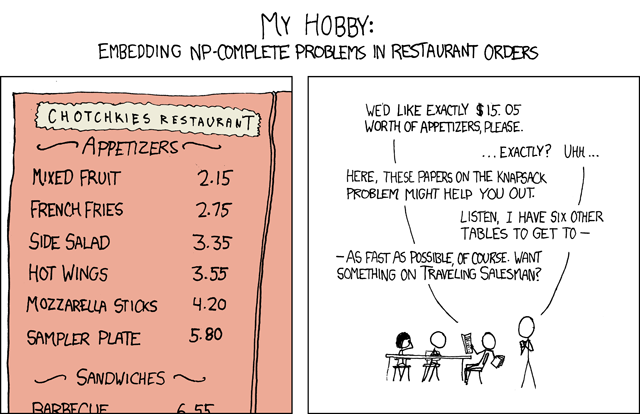7. Mixed-Integer Linear Programming¶
7.1. Ice Cream¶
This example was originally contributed by Joshua Lerman.
An ice cream stand sells cones and popsicles. It wants to maximize its profit, but is subject to a budget.
We can write this problem as a linear program:
max cone \(\cdot\) cone_margin + popsicle \(\cdot\) popsicle margin
subject to
cone \(\cdot\) cone_cost + popsicle \(\cdot\) popsicle_cost \(\le\) budget
In [1]:
cone_selling_price = 7.
cone_production_cost = 3.
popsicle_selling_price = 2.
popsicle_production_cost = 1.
starting_budget = 100.
This problem can be written as a cobra.Model
In [2]:
from cobra import Model, Metabolite, Reaction
cone = Reaction("cone")
popsicle = Reaction("popsicle")
# constrainted to a budget
budget = Metabolite("budget")
budget._constraint_sense = "L"
budget._bound = starting_budget
cone.add_metabolites({budget: cone_production_cost})
popsicle.add_metabolites({budget: popsicle_production_cost})
# objective coefficient is the profit to be made from each unit
cone.objective_coefficient = \
cone_selling_price - cone_production_cost
popsicle.objective_coefficient = \
popsicle_selling_price - popsicle_production_cost
m = Model("lerman_ice_cream_co")
m.add_reactions((cone, popsicle))
m.optimize().x_dict
Out[2]:
{'cone': 33.333333333333336, 'popsicle': 0.0}
In reality, cones and popsicles can only be sold in integer amounts. We can use the variable kind attribute of a cobra.Reaction to enforce this.
In [3]:
cone.variable_kind = "integer"
popsicle.variable_kind = "integer"
m.optimize().x_dict
Out[3]:
{'cone': 33.0, 'popsicle': 1.0}
Now the model makes both popsicles and cones.
7.2. Restaurant Order¶
To tackle the less immediately obvious problem from the following XKCD comic:
In [4]:
from IPython.display import Image
Image(url=r"http://imgs.xkcd.com/comics/np_complete.png")
Out[4]:

We want a solution satisfying the following constraints:
\(\left(\begin{matrix}2.15&2.75&3.35&3.55&4.20&5.80\end{matrix}\right) \cdot \vec v = 15.05\)
\(\vec v_i \ge 0\)
\(\vec v_i \in \mathbb{Z}\)
This problem can be written as a COBRA model as well.
In [5]:
total_cost = Metabolite("constraint")
total_cost._bound = 15.05
costs = {"mixed_fruit": 2.15, "french_fries": 2.75,
"side_salad": 3.35, "hot_wings": 3.55,
"mozarella_sticks": 4.20, "sampler_plate": 5.80}
m = Model("appetizers")
for item, cost in costs.items():
r = Reaction(item)
r.add_metabolites({total_cost: cost})
r.variable_kind = "integer"
m.add_reaction(r)
# To add to the problem, suppose we want to
# eat as little mixed fruit as possible.
m.reactions.mixed_fruit.objective_coefficient = 1
m.optimize(objective_sense="minimize").x_dict
Out[5]:
{'french_fries': 0.0,
'hot_wings': 2.0,
'mixed_fruit': 1.0,
'mozarella_sticks': 0.0,
'sampler_plate': 1.0,
'side_salad': 0.0}
There is another solution to this problem, which would have been obtained if we had maximized for mixed fruit instead of minimizing.
In [6]:
m.optimize(objective_sense="maximize").x_dict
Out[6]:
{'french_fries': 0.0,
'hot_wings': 0.0,
'mixed_fruit': 7.0,
'mozarella_sticks': 0.0,
'sampler_plate': 0.0,
'side_salad': 0.0}
7.3. Boolean Indicators¶
To give a COBRA-related example, we can create boolean variables as integers, which can serve as indicators for a reaction being active in a model. For a reaction flux \(v\) with lower bound -1000 and upper bound 1000, we can create a binary variable \(b\) with the following constraints:
\(b \in \{0, 1\}\)
\(-1000 \cdot b \le v \le 1000 \cdot b\)
To introduce the above constraints into a cobra model, we can rewrite them as follows
\(v \le b \cdot 1000 \Rightarrow v- 1000\cdot b \le 0\)
\(-1000 \cdot b \le v \Rightarrow v + 1000\cdot b \ge 0\)
In [7]:
import cobra.test
model = cobra.test.create_test_model("textbook")
# an indicator for pgi
pgi = model.reactions.get_by_id("PGI")
# make a boolean variable
pgi_indicator = Reaction("indicator_PGI")
pgi_indicator.lower_bound = 0
pgi_indicator.upper_bound = 1
pgi_indicator.variable_kind = "integer"
# create constraint for v - 1000 b <= 0
pgi_plus = Metabolite("PGI_plus")
pgi_plus._constraint_sense = "L"
# create constraint for v + 1000 b >= 0
pgi_minus = Metabolite("PGI_minus")
pgi_minus._constraint_sense = "G"
pgi_indicator.add_metabolites({pgi_plus: -1000,
pgi_minus: 1000})
pgi.add_metabolites({pgi_plus: 1, pgi_minus: 1})
model.add_reaction(pgi_indicator)
# an indicator for zwf
zwf = model.reactions.get_by_id("G6PDH2r")
zwf_indicator = Reaction("indicator_ZWF")
zwf_indicator.lower_bound = 0
zwf_indicator.upper_bound = 1
zwf_indicator.variable_kind = "integer"
# create constraint for v - 1000 b <= 0
zwf_plus = Metabolite("ZWF_plus")
zwf_plus._constraint_sense = "L"
# create constraint for v + 1000 b >= 0
zwf_minus = Metabolite("ZWF_minus")
zwf_minus._constraint_sense = "G"
zwf_indicator.add_metabolites({zwf_plus: -1000,
zwf_minus: 1000})
zwf.add_metabolites({zwf_plus: 1, zwf_minus: 1})
# add the indicator reactions to the model
model.add_reaction(zwf_indicator)
In a model with both these reactions active, the indicators will also be active
In [8]:
solution = model.optimize()
print("PGI indicator = %d" % solution.x_dict["indicator_PGI"])
print("ZWF indicator = %d" % solution.x_dict["indicator_ZWF"])
print("PGI flux = %.2f" % solution.x_dict["PGI"])
print("ZWF flux = %.2f" % solution.x_dict["G6PDH2r"])
PGI indicator = 1
ZWF indicator = 1
PGI flux = 4.86
ZWF flux = 4.96
Because these boolean indicators are in the model, additional constraints can be applied on them. For example, we can prevent both reactions from being active at the same time by adding the following constraint:
\(b_\text{pgi} + b_\text{zwf} = 1\)
In [9]:
or_constraint = Metabolite("or")
or_constraint._bound = 1
zwf_indicator.add_metabolites({or_constraint: 1})
pgi_indicator.add_metabolites({or_constraint: 1})
solution = model.optimize()
print("PGI indicator = %d" % solution.x_dict["indicator_PGI"])
print("ZWF indicator = %d" % solution.x_dict["indicator_ZWF"])
print("PGI flux = %.2f" % solution.x_dict["PGI"])
print("ZWF flux = %.2f" % solution.x_dict["G6PDH2r"])
PGI indicator = 1
ZWF indicator = 0
PGI flux = 9.82
ZWF flux = 0.00